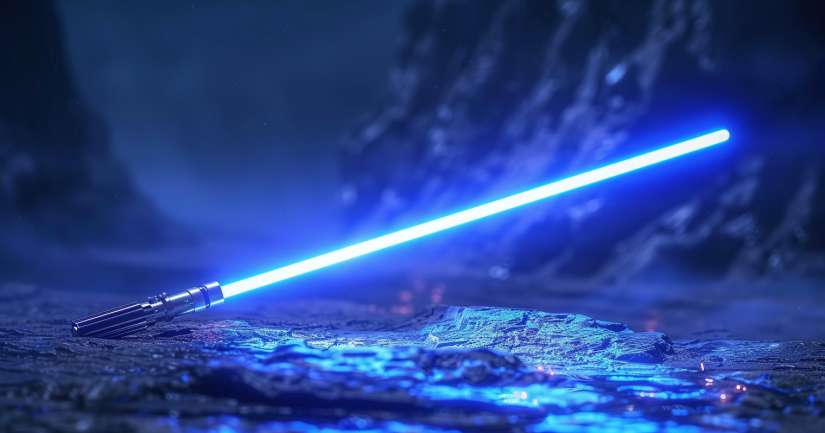
From ancient temples on Ilum to the halls of the Jedi Temple on Coruscant, the Star Wars Lightsaber Quiz dives deep into the galaxy’s most iconic weapon a blade of plasma, powered by a kyber crystal, and shaped as much by the wielder’s spirit as by the Force itself. Lightsabers are more than elegant weapons; they’re reflections of identity, philosophy, and legacy. Their colors, construction methods, and combat styles reveal far more about the galaxy’s factions and Force-users than any spoken doctrine ever could.
The development of a lightsaber represents a rite of passage. Padawans undergo the Gathering to find a kyber crystal attuned to their unique presence in the Force. Sith twist their crystals through agony and domination, forcing them to “bleed” red. The Star Wars Lightsaber Quiz explores the meanings embedded in each variant from Mace Windu’s amethyst blade, which signaled balance between aggression and restraint, to the ancient darksaber, forged by the first Mandalorian Jedi. Understanding lightsabers means tracing the history of the Force itself, from Jedi Code to Sith Rule of Two, and every war in between.
The Lore Behind Lightsaber Colors
Each color of lightsaber represents more than a visual flourish it carries distinct cultural, symbolic, and historical significance. Blue, most commonly associated with Jedi Guardians like Anakin and Obi-Wan, reflects discipline and a dedication to combat. Green, favored by Jedi Consulars such as Yoda and Qui-Gon Jinn, symbolizes wisdom and a deeper connection to the spiritual aspects of the Force. Red, the color of nearly every Sith blade, results from the kyber crystal being corrupted and “bled” through intense dark side manipulation.
Other colors are far rarer but no less meaningful. Mace Windu’s purple blade, canonically achieved through his unique control of both light and dark side emotions, signals internal complexity and formidable power. Yellow, as used by Jedi Temple Guards and Rey, reflects a balance between scholarly and martial pursuits a commitment to protection without domination. The white blades of Ahsoka Tano mark purification, the reclaiming of corrupted crystals, and a refusal to be defined by Jedi or Sith ideologies. Each blade becomes a mirror, not just of allegiance, but of a Force user’s inner life.
Understanding these colors requires looking at the broader narratives around each wielder. The choices that led to their weapon, the battles they fought with it, and the way they ultimately used or abandoned it speak volumes. Lightsabers don’t lie; they reveal.
Kyber Crystals, Construction, and the Bond with the Force
At the heart of every lightsaber lies a kyber crystal a rare, Force-sensitive mineral that must be attuned through meditation and connection. The process of bonding with a kyber crystal is intensely personal. Jedi initiate their first blade by journeying to sacred crystal caves, while Sith take their crystals through domination and violence, forcibly shaping them to their will. This divergence reflects the ideological chasm between the two orders and shapes the way their blades function in battle and narrative.
Kyber crystals are colorless until attuned. Once bonded, they not only take on a color but a resonance unique to their wielder. They can reject Force users who are unworthy or unstable, and some even develop limited forms of sentience. The manipulation of these crystals bleeding, healing, or balancing them is itself a form of Force interaction. They are more than batteries or power sources. They are conduits of purpose, tied to the very fabric of the Force.
The construction of a lightsaber is a sacred rite. From emitter matrix to focusing lens, each component is selected with intention. Jedi must construct their own weapon as a final trial before knighthood, reflecting discipline, creativity, and harmony with the Force. This process isn’t mechanical it’s spiritual. A properly constructed saber feels alive in the hand, humming with connection and ready to respond to thought as much as movement.
Combat Forms and Famous Wielders
The use of a lightsaber is as nuanced as its construction. Seven primary combat forms exist, each with its own philosophy, strengths, and weaknesses. Form I, Shii-Cho, focuses on disarming and simplicity it’s often taught to younglings. Form II, Makashi, emphasizes precision and dueling, favored by Sith like Count Dooku. Form III, Soresu, perfects defense, with Obi-Wan Kenobi as its most iconic master. Each form responds to different threats and reflects a user’s mindset and values in battle.
Form IV, Ataru, is an acrobatic, aggressive form practiced by Yoda and Ahsoka. Form V, used by Anakin and later Darth Vader, channels power and aggression into counter-attacks. Form VI blends multiple techniques, offering flexibility but often criticized as unfocused. Form VII, Juyo/Vaapad, is the most dangerous skirting dangerously close to the dark side, it was mastered by only a few, including Mace Windu. Knowledge of these forms allows for a richer understanding of the duels that define Star Wars history, from Mustafar to the Death Star to Exegol.
Famous wielders leave their mark not just on galactic history, but on the evolution of lightsaber use itself. Luke Skywalker built his green saber from Obi-Wan’s notes, signaling his spiritual maturity. Kylo Ren’s unstable blade reflected his fractured mind. The Darksaber, wielded by both Jedi and Mandalorians, blends saber combat with cultural identity, showing how the weapon can serve politics as much as battle. These stories are encoded in the blades themselves if you know how to read them.
Lightsabers are more than tools of war. They are texts written in crystal and light, carrying within them the history of every wielder and every cause. Understanding them is key to understanding the Force and the galaxy it shapes.
